- This photo
feature by art historian Benoy K Behl tells you about Sanchi Stupa, including
its sculptures. It has o/s pictures with detailed captions. Some images are found
in churches of Spain and Portugal, captions have the details.
An earlier
article Who Made Sanchi Stupa. Text
and Photographs by Benoy K Behl
The
Sunga and Satvahana periods
Between 185 and 73 BCE, during the rule of
the Sunga Dynasty, foundations were laid for the rich traditions of art of the
Indian subcontinent. The harmony and interrelatedness of the whole of creation
became the underlying theme of all art. This is best represented by the
continuous, undulating vine of life, from which springs the bounty of nature,
the numerous forms of the world around us.
The forms of the world were sculpted on
the railings and gateways around stupas. These vedikas and toranas
separate the mundane, day-to-day world from the sacred space, at the centre of
which is the stupa. These sculptural representations help us to appreciate all
forms of life in their true perspective, as reflections of that formless
eternal, towards which we must proceed. Beyond the railings and gateways a
profoundly simple representation, a stupa, points out the Truth towards which
we must strive, leaving behind the forms and attractions of the world.
Another tradition that was clearly
established at this time was that of the indirect royal
patronage of all sacred monuments, which lasted through most of the ancient period. No king patronised the making of such edifices dedicated to any faith. However, they provided revenues to all faiths, for the upkeep of these establishments and for the monks and bhikshus gathered there. The earliest Buddhist art, with themes from the Buddha’s life and Jataka stories, was made under the rule of the Sungas. Sunga rulers generously endowed the revenue from many villages for the running and maintenance of Buddhist places of worship.
Sanchi
Stupas
The city of Vidisha, present-day Besnagar in Madhya Pradesh, was on the trade route which connected the plains of the Ganga to the Western Coast. It was also a great market place, at the centre of the vast and fertile plains of Central India. Among the earliest objects to be found here is a large stone pillar with an inscription, dated between 120–100 BCE. It was set up by a Greek devotee named Heliodorus, in honour of Vasudeva,
another name of Lord Vishnu.
At Sanchi, on a low hill next to Vidisha,
are the finest surviving early Buddhist stupas. Halfway up the hill, is a stupa which contains the relics of prominent Buddhist
teachers of the Mauryan period. The Vedika made around the stupa dates
to around 100 BCE. The Vedika has medallions and half-medallions which contain
sculptural relief. Corner pillars at the entrances are fully carved. The deity
of prosperity and abundance Lakshmi is seen with elephants pouring water over
her. The panel is carved in shallow relief and the style is similar to that of
Bharhut.
The greatest surviving Buddhist stupa of
the BCE period is on top of the hill at Sanchi. It is likely to have enshrined
the relics of the Buddha. The stupa was originally made in the third century
BCE. There is an Ashokan pillar at the southern entrance of the stupa. In the
middle of the second century BCE, it was doubled in size and its previous wooden Vedika was replaced with a massive stone
one.
By the end of the first century BCE, the
Satavahanas, kings of the Deccan region, extended their rule to Central India. Major stone renovations that were carried out during
their reign made this stupa one of the most significant of all Buddhist
monuments. Four gloriously carved stone Toranas, 34 feet in height were
made. They were completed in the first century CE. The traditions of art
established during the time of the Sungas became more sophisticated in these
magnificent Toranas, made in the time of the Satavahanas.
The carvings were a result of the
donations by the people of Vidisha, a fact revealed by the 631 inscriptions on
the toranas. The donors included gardeners, merchants, bankers, fishermen,
housewives, householders, nuns and monks. Interestingly,
almost half the donations were made by women.
The massive Vedikas are plain and without
carvings. The Toranas have two upright pillars, which support three horizontal
bars or architraves. On the east and north Toranas, between the pillars and the
architraves, are superbly made elephants, sculpted almost completely in the
round. The west gateway has Ganas or dwarves. The one on the south has Lions.
The Ganas are shown with rolls of fat and
vast bellies which bulge over their dhotis. They have individualized facial
expressions. Ganas continued as a favourite motif
of the Indian artist, in the centuries to come. They deepen the sense of
the reality presented in the art, where the humorous and the sublime co-exist,
reminding us that everything has its place in existence. In later times, ganas
become an integral feature in Shiva temples.
The veneration of nature’s fertility and abundance, as seen at Bharhut, continues here. Twenty-four auspicious Yakshis are made as bracket figures on the gateways. On the east Torana is a beautifully-made Yakshi who holds the branch of a mango tree above her. The notion of the creative vitality of nature and its fruitfulness is convincingly portrayed. Though she is physically attached to the matrix, she is sculpted as though fully in the round. Details, seen from all possible angles, including the rear, are carefully articulated.
As at Bharhut, male figures are made
guarding the entrances to the sacred stupa. One figure is in Indic garb, a dhoti and turban. Another wears Greek
garments and carries a foreign-type shield and spear. It may be noted
that, in early Indian art, soldiers are generally depicted as foreigners.
The reliefs on the Toranas depict
incidents from the Jatakas, as well as events from the life of Gautama Buddha. The focus is still not on the personality of the Buddha,
who is represented by symbols. The wheel represents the first teaching
of the Dharma; the Bodhi tree represents Enlightenment; while footprints and an
umbrella over a vacant space proclaim the presence of an Enlightened One.
The Toranas of the stupa at Sanchi present
a view of the overflowing activity of life. The pictorial setting of the
narratives richly reflects contemporaneous town and village life. These reliefs
at Sanchi are the most important visual record of the architecture and
lifestyles of the period. Stylistically, the Sanchi reliefs display a greater
sophistication than the ones at Bharhut. Whereas single figures were made at
Bharhut, here there are large groups of many figures. Men, women, children and
animals are shown in a variety of poses and in the midst of exuberant life.
They are no longer depicted only frontally: instead, three-quarter profiles are
also seen. The Sanchi artist also depicts a wide range of expressions
effortlessly.
The Sanchi artists utilized multiple
perspectives and viewpoints. This allowed them to present that view through
which the object or person was most easily recognised. Events that occurred and
figures that are in the distance are represented in the upper part of the
panel, while those figures which are closest to the viewer, are shown in the
lower section. The technique of receding perspective is not employed here. All
elements which are considered important are presented large and in clear
detail. Another feature of Indian art seen from earliest times is that the
leaves of a plant or tree were large, so they could be recognized.
There is an inscription on the eastern Torana
of the stupa which mentions that the exquisite carvings on the toranas are the
work of ivory carvers of Vidisha.
Indeed, the stone is so finely carved here that it reflects the care and
detail of work on delicate ivory.
A smaller stupa at Sanchi contained the relics of the Buddha’s close disciples Modgalyana and Sariputra. The only torana here was also made under the supervision of the Satavahanas in the first century CE. As in the earlier stupas, the sculptures present a vision of the world which sees the unending rhythm in all of creation. There are numerous representations of Purnaghatas, or ‘vases of plenty’, from which come forth the joyous forms of the world. The vine of creative blossoming moves with a pulsating life through the Vedika. It brings to us the natural order in its myriad forms: flowers, fruit, animals, humans and composite creatures.
These are traditions which continued in
Indian art in later times and spread far and vide, beyond the shores of India. Purnaghatas, with pillars rising out of them, as in
Buddhist caves, are seen in the early mosques and even sometimes in
contemporaneous pillars in Indonesia. All these motifs of the fruitfulness of
nature are depicted in similar form and in profusion in the early churches of
Spain and Portugal.
While the great stupas at Sanchi were
being built and carved in the plains of Madhya Pradesh, the Satavahanas and the Kstrapas ruled over the Deccan. They
encouraged and extended their benevolent patronage towards Buddhist establishments.
Scores of caves dedicated to the Buddhist tradition and numerous impressive
stupas were made during their rule, across the Western Ghats and the Deccan, in
present-day Maharashtra, Andhra Pradesh and Karnataka.
We now feature pictures by author.
 Stupa II, c. 100 BCE. Photograph by Benoy
K Behl
Stupa II, c. 100 BCE. Photograph by Benoy
K Behl
Made in Sunga times, the reliefs on the Vedika
of this stupa are among the oldest Buddhist art in the world. These depictions
continue the rich visual lore of the land and show the roots of the specific Buddhist
imagery to come in later centuries.
 Composite Creature, Stupa II, Sanchi c. 100 BCE. Photograph by Benoy
K Behl
Composite Creature, Stupa II, Sanchi c. 100 BCE. Photograph by Benoy
K Behl
The depiction displays the oneness of all
life forms. It is such a delightful and
joyous creature, with the qualities of an elephant, cow, deer and even a
horse. All of creation is seen in a
vision full of warmth.
 Shalabhanjika, East Gateway Stupa I, Sanchi first
century CE.
Photograph by Benoy K Behl
Shalabhanjika, East Gateway Stupa I, Sanchi first
century CE.
Photograph by Benoy K Behl
The best-known sculpture of the Sanchi
stupas is this exquisite shalabhanjika, who depicts fertility and abundance.
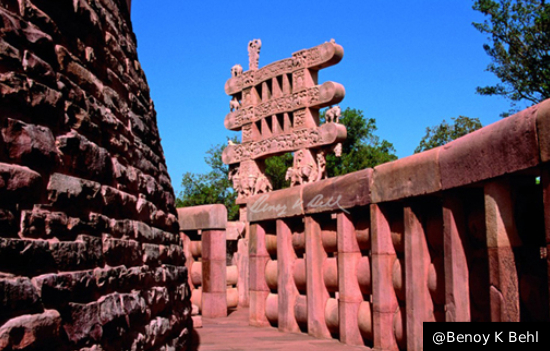 The Great Stupa, East Gateway, inner view, Stupa I,
Sanchi first century CE. Photograph by Benoy K Behl
The Great Stupa, East Gateway, inner view, Stupa I,
Sanchi first century CE. Photograph by Benoy K Behl
The Vedika creates a passage for the
circumambulation of the stupa.
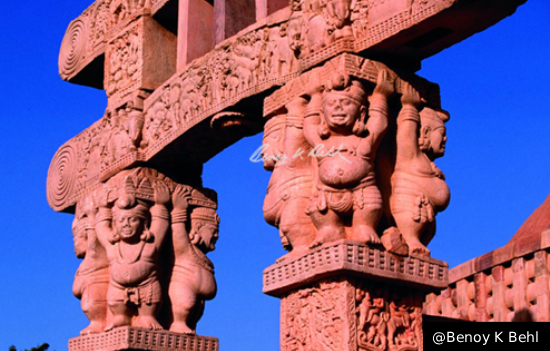 Ganas supporting architraves, West Gateway Stupa I,
Sanchi, first century CE. Photograph by Benoy K Behl
Ganas supporting architraves, West Gateway Stupa I,
Sanchi, first century CE. Photograph by Benoy K Behl
Ganas are among the early images of Indian
art, which continue through all the ages. They deepen the reality conveyed in
the art, as the whole of life includes multiple aspects, from the humorous to
the sublime.
 Detail, the unending vine of the natural life force,
South Gateway Stupa I, Sanchi, first century CE. Photograph
by Benoy K Behl
Detail, the unending vine of the natural life force,
South Gateway Stupa I, Sanchi, first century CE. Photograph
by Benoy K Behl
The art of Bharhut and Sanchi brings us
the unending vine, which carries the numberless forms of the natural world. The
Yaksha comes out of the undulating vine of life, carrying a garland. Out of his
mouth is again disgorged the vine of life, bringing forth the fruits and
flowers of the natural world.
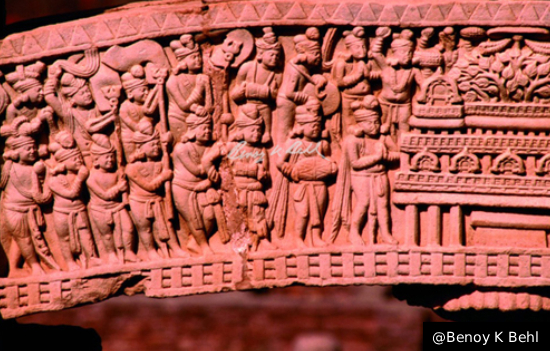 Detail, Graceful Devas, Enlightenment Scene, West Gateway, inner face, Stupa
I, Sanchi, first century CE. Photograph by Benoy K Behl
Detail, Graceful Devas, Enlightenment Scene, West Gateway, inner face, Stupa
I, Sanchi, first century CE. Photograph by Benoy K Behl
This scene is one of the finest sculpted
at Sanchi, with gentle and graceful expressions on the faces of the figures.
These devas are gathered on the occasion of Enlightenment, to pay homage to Gautama
Buddha.
 Detail, Vessantra Jataka, North Gateway, inner face,
Stupa I, Sanchi, first century CE. Photograph by Benoy
K Behl
Detail, Vessantra Jataka, North Gateway, inner face,
Stupa I, Sanchi, first century CE. Photograph by Benoy
K Behl
Prince Vessantra is a previous birth of
Gautama Buddha. In this Jataka tale, he exemplifies the quality of generosity.
He gifts everything that he has and was left with nothing.
 Worship of Seven Buddhas, represented by trees, East
Gateway, Stupa I, Sanchi, first century CE. Photograph by Benoy
K Behl
Worship of Seven Buddhas, represented by trees, East
Gateway, Stupa I, Sanchi, first century CE. Photograph by Benoy
K Behl
The Seven Manushi Buddhas are the Buddhas
or Enlightened Ones of the world, of whom Gautama Buddha is one. As individual personalities were not as yet shown in
Indic art, they are represented here as trees.
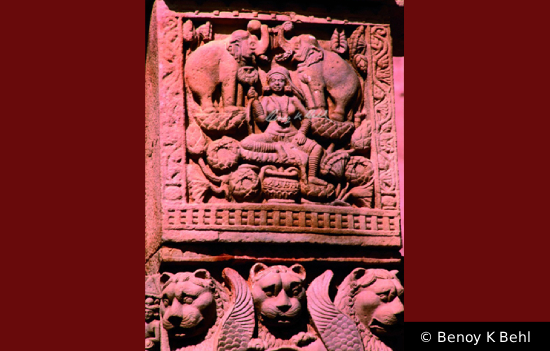 Lakshmi, deity of abundance and prosperity, with elephants pouring water
on her, East Gateway, Stupa I, Sanchi, first century CE. Photograph by Benoy
K Behl
Lakshmi, deity of abundance and prosperity, with elephants pouring water
on her, East Gateway, Stupa I, Sanchi, first century CE. Photograph by Benoy
K Behl
This is also interpreted as Queen Maya,
mother of Prince Siddhartha. From the earliest Sanchi stupa and the Bharhut
stupa onwards, one of the earliest deities we see
in Indic art is Lakshmi, who represents the abundance and riches of nature. Photograph by Benoy K Behl
 Lord Indra with Vajra, Pillar of East Gateway, Stupa
I, Sanchi, first century CE. Photograph by Benoy K Behl
Lord Indra with Vajra, Pillar of East Gateway, Stupa
I, Sanchi, first century CE. Photograph by Benoy K Behl
Among
the earliest deities seen in Buddhist art is Lord
Indra. The vajra or thunderbolt which he holds in his hand, later became
the symbol of the Vajrayana school of Buddhism.
 North Gateway, inner view, Stupa I, Sanchi, first
century CE. Photograph
by Benoy K Behl
North Gateway, inner view, Stupa I, Sanchi, first
century CE. Photograph
by Benoy K Behl
These magnificent gateways, carved on both
sides, are among the finest works of Indian art. The themes are carved in fine
detail remind us of the inscription which mentions that these reliefs were the
work of the ivory carvers of Vidisha.
 Worship of stupa, pillar, North Gateway, Stupa I,
Sanchi, first century CE. Photograph by Benoy K Behl
Worship of stupa, pillar, North Gateway, Stupa I,
Sanchi, first century CE. Photograph by Benoy K Behl
As images of individual personalities were
not shown in Indic art at this early stage, symbols such as this stupa indicate
the Buddha in the art of Sanchi.
 Detail, the unending vine of the natural life force, South Gateway Stupa
I, Sanchi, first century CE. Photograph
by Benoy K Behl.
Detail, the unending vine of the natural life force, South Gateway Stupa
I, Sanchi, first century CE. Photograph
by Benoy K Behl.
Yakshas are seen here, disgorging the
unending vine of the life of the natural world around us. The vine is continuous
and brings the forms and fruits of the world. The yakshas carry auspicious
flower garlands in their hands. This is a theme in
Indian art which runs through the ages to come. As we go to the stupa or
to the temple, we are constantly shown the illusory world of forms all around
us. This art is a remarkable lesson, which shows how the force of Maya or
Mithya creates the world of nature in which we live.
 Purnaghata (vase of plenty), detail, vedika, Stupa II, c. 100, BCE. Photograph
by Benoy K Behl
Purnaghata (vase of plenty), detail, vedika, Stupa II, c. 100, BCE. Photograph
by Benoy K Behl
As in the case of the yaksha, the Purnaghata, or ‘vase of plenty’, has the life of nature coming out of it. This is one of the most common motifs in Indian art. Even the pillars in caves of the early period are seen rising out of such ‘vases of plenty’.
 Composite creature, detail, vedika, Stupa II, c. 100, BCE. Photograph
by Benoy K Behl
Composite creature, detail, vedika, Stupa II, c. 100, BCE. Photograph
by Benoy K Behl
The oneness of all life forms is displayed
in these delightful creatures. Here we see the connectedness of the life of
fish, a bull and a crocodile. The creature spews out of his mouth the vine of
life and flowers, representing the vibrant life of the natural order.
 Lion disgorging the vine of life, detail, fresco, Patio del Yeso,
Seville, Spain, late medieval period. Photograph by Benoy K Behl
Lion disgorging the vine of life, detail, fresco, Patio del Yeso,
Seville, Spain, late medieval period. Photograph by Benoy K Behl
This image is remarkably similar to the
themes of ancient Indian art which are seen everywhere in Bharhut, Sanchi and
thereafter. The lion disgorges the vine of life which moves all around him and
brings forth the blossoms of the natural world.
Spain and Portugal were under Arab rule
for about eight centuries, from the early eight century onward. This was the
period in which Western Europe imbibed many concepts of science, mathematics,
medicine, agriculture, art, literature, music, rational thinking and knowledge
of Greek philosophy and science, from the Arab rulers. This was the period
which transformed Western Europe. Much of what the
Arabs brought to Europe was Indian in origin, including Arabic translations of
the ancient Indian astronomer and mathematician Aryabhatta. In fact, the numerals of mathematics which the Arabs brought were called ‘Hindi’ by them, as they came from the Indian sub-continent.
Along with ideas of astronomy and mathematics, the Arabs must have been the carriers of the highly-developed motifs of ancient Indian art, which we see in the early European Churches, after the Arab influence. European art historians were not familiar with ancient Indian art and these thousands of representations have been called “pagan”. Actually, these are highly-developed
philosophical themes of ancient Indian art which appear to have travelled to
Europe with the Arab influence.
 Composite creature, fresco, Patio del Yeso, Seville, Spain, late medieval
period.
Photograph by Benoy K Behl
Composite creature, fresco, Patio del Yeso, Seville, Spain, late medieval
period.
Photograph by Benoy K Behl
Thousands of such composite creatures were
made across the early churches of Spain, Portugal and Italy, showing a
remarkable similarity with the themes of ancient Indian art, from the second
century BCE onward.
Just like in the art of the Sunga period,
this creature shows a connectedness of all life forms, ranging from the plant
life seen below, snakes with wings, humans and finally the leaves which are
seen on his head. This figure would be termed a kinnara in Indian art. He also reminds us of the numerous naga-devas. The
endless vine of life is also seen on either side of him.
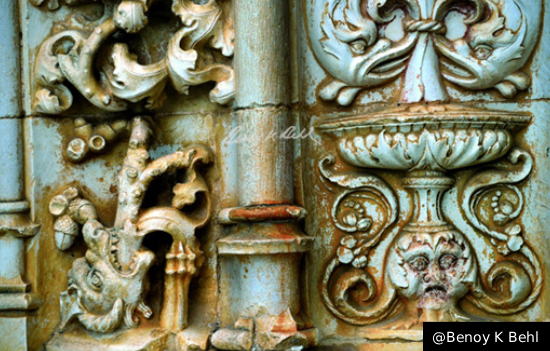 Doorway details, Convento De Cristo, Tomar, Portugal, early medieval
period.
Photograph by Benoy K Behl
Doorway details, Convento De Cristo, Tomar, Portugal, early medieval
period.
Photograph by Benoy K Behl
Here we see on the left a creature with
horns and a ferocious mouth, disgorging the continuous vine of life. He is made
just like the vyalas and yakshas in ancient Indian art, from whose mouth
emanates the stream of life. On the right, we see a vase, like the Purnaghatas
of Indian art, from which comes forth the treasure of the natural order.
 Doorway, detail, Convento De Cristo, Tomar, Portugal, early medieval
period.
Photograph by Benoy K Behl
Doorway, detail, Convento De Cristo, Tomar, Portugal, early medieval
period.
Photograph by Benoy K Behl
To the side of the entrance to the
convent, we see a vase, from which comes forth the life of the natural world.
This is exactly the theme we see in the ancient stupas and temples, including
the easy contiguity which is presented between the animal and plant world.
 Doorway, Convento De Cristo, Tomar, Portugal, early medieval period. Photograph
by Benoy K Behl
Doorway, Convento De Cristo, Tomar, Portugal, early medieval period. Photograph
by Benoy K Behl
It is amazing to see the representation of the ‘vases of plenty’, the vyalas and the continuous vine of life, carrying in it numerous creatures, joyously presenting the world of nature, in the carvings around the doorway. These are exactly the themes made at the doorway of ancient Indian stupas.
In later Indian temples of the ancient and
the medieval period, these themes are made in parallel bands which move around
the doorway, precisely as we see them made here.
To read all
articles by author Benoy K Behl
To see albums of
Buddhist Monuments
To read articles
on Buddha Vakhya